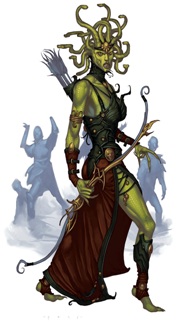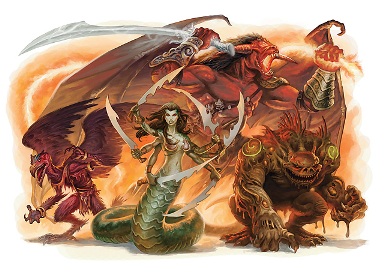
![]() Recognizing and reducing game slowdown caused by a proliferation of triggers or immediate actions and interrupts isn’t just a player character issue in combat encounters. Dungeon Masters must also do themselves and the playgroup a favor by analyzing monster complexity and making smarter monster selections when encounter building.
Recognizing and reducing game slowdown caused by a proliferation of triggers or immediate actions and interrupts isn’t just a player character issue in combat encounters. Dungeon Masters must also do themselves and the playgroup a favor by analyzing monster complexity and making smarter monster selections when encounter building.
The (unfortunate) reality is, monster or encounter themes, flavor and atmosphere don’t always mesh with a smooth and easy-to-run encounter. It’s important to look over monsters and understand their complexity and potential slowdown impact when put together, not just individually.
To illustrate where monster complexity and selection can easily cross the slowdown line, allow me to briefly recount a thematically flavorful early paragon tier encounter I created and ran a few months ago.
The Medusae Invaders
The party of tribal characters was investigating the grounds of a monastery ruin, built inside a mountain overlooking a frozen ocean. A light fog lingered over the ruin while some patches of rubble, a handful of shallow recesses, and a host of broken and crumbling statues and low walls dotted the grounds. A group of medusae (two venom-arrows, two bodyguards, and their leader, a spirit-charmer) as well as their snake swarm and basilisk beast servants sneaked up on the party under cover of the fog, statues and walls, firing the first arrow into the unsuspecting heroes’ midst.
Sounds like a thematically fitting and potentially engaging and challenging encounter, doesn’t it? Flavorful location? Check. Petrification and serpentine monster themes? Check. Variety of monster types, roles and tactics? Check. A few interactive or tactical terrain and area features? Check.
Low slowdown risk? Fail.
Unfortunately, while I had highlighted all the monsters’ immediate actions and triggers to check for throughout the encounter, I hadn’t considered the cumulative effect of time costs and interruptions by all the ‘checks’ I needed to look for on both my turn and the PCs’ turn. The complexity of executing the encounter in anything resembling elegance quickly became apparent. Suddenly, my flavorful encounter I was so excited to present and run was a mechanical abomination, consuming droves of session time and DM sanity!
Taking a closer look at the specific monsters, you’ll see a host of additional game checks you have to make throughout combat – and worst of all, collectively, their triggers and timing vary greatly, creating massive slowdown.
The medusa bodyguard’s mind-venom gaze is based off violating their mark, much like PC defenders. The medusa venom-arrow’s petrifying stare checks for enemy positioning at the start of the venom-arrow’s turn, with additional game checks and effects at both the first and second save failures. Finally, the medusa spirit-charmer’s stony glare triggers based on enemy positions at the end of their turns, and also includes tracking only a third failed save, as the stony glare petrifies on the third failure. Running some combination of any five of these medusa – a very believable and, on the surface, captivating encounter – is, in actuality, a nightmare of tactical timing, checks, pauses and interruptions.
Now factor in the triggered action-like auras of the snake swarms, and both the baleful gaze aura and petrifying gaze save failure checks for the basilisks, and you should have a very clear picture right now of why my head almost exploded.
Needless to say, I was disappointed with the triggered action and timing check glut because of the massive slowdown and time cost. An exciting and colorful encounter dragged on far too long with far too many tactical checks. And this encounter even included an alternate victory condition – nearly kill the leader (the spirit-charmer) and the medusae will flee back through the Feywild portal they slithered over from, deeper inside the monastery grounds. Fortunately, that’s exactly what happened. I can’t even imagine the time and sanity cost if the encounter goal was “kill everything/fight to the death.”
So what’s the lesson here? Once you have a particular evocative story, location and themes in mind and are on the monster selection step, be sure to review all of the monsters’ triggered actions, including any traits or free actions that function much like the tactical checks or interruptions that are triggered actions. Keep the number of them low, and try to keep timing triggers consistent.
For example, it may have been better to have designed all Monster Vault medusae gazes to trigger at the same time – either at the start or end of enemy turns, but certainly not both! Or alternatively, to only use two or a single medusa type, and more of them.
This latter strategy, however, I don’t particularly like, as now you’re letting the complexity of the mechanics truly dictate how flavorful and believably populated a thematic encounter might be. That’s a problem. The complexity of the mechanics should not get in the way of the story and smoothly executing evocative, engaging encounters. And yet, especially in 4e with combat’s rich tactics, teamwork, and complexity, that’s precisely what can happen during monster selection.
How about a well-designed monster? One whose complexity is low enough without sacrificing too much in the way of tactical modes (i.e. offense, defense, mobility, etc.) and attack options?

The Marilith Demon
Let’s look at demons, who, much like medusae, are iconic monsters of both mythology and D&D.
Specifically, take a look at the marilith. The marilith has two triggers. The variable resistance is easily categorized as a low-complexity triggered action – it’s not always helpful unless the party relies heavily on specific damage types, and is extremely easy and quick to execute and track. Hacking Blades triggers off missed enemy attacks – also easy and quick to track and execute. Weapon Dance is a twice-only encounter attack, the marilith’s top offensive option, while Shroud of Steel provides an elegant and easy-to-run defensive option and attack all in one.
Add in high mobility (Speed 8), darkvision, standard elite buffs of saving throw bonuses and an action point, flavorful trained skills (Bluff, Insight, Intimidate and Stealth) to build a story and alternate starting encounter conditions or alternative encounter goals around, and you can understand why the marilith has proudly appeared in a whopping seven different D&D 4e sourcebooks and published adventures. Simply put? It’s as close to a perfect monster you can get from both a flavor and crunch perspective.
And most importantly, the crunch’s complexity isn’t too high on the marilith. You’re not pausing the action to make tactical timing checks for a host of various triggers and aura or any failed save tracking. The triggers you do have to track are simple, and the most exciting trigger is a simple basic attack – easy and quick to resolve.
Reaching for Monster Efficiency
So the next time you craft your encounters from start to finish, double-check the trigger complexity of your monsters as a group. Reduce or even eliminate triggers and all the associated tracking, interruptions and time costs. When using triggers, align their timing, whether by using more of the same monster, or using monsters whose trigger checks simply happen to match.
Finally, don’t be afraid to take some liberties as a DM and change a trigger’s timing on the spot. You can make it subtle and minor by simply aligning it with other creatures’ timing – i.e. its trigger now checks for enemy positioning at the start of its turn, like the other monsters – such as could have been done in retrospect with the medusae encounter above.
You could also remove triggered action attacks or damaging auras by giving monsters’ other attacks a damage bonus, greatly reducing tactical check slowdown, while still capturing the essence and goal of heightened damage-based threat. Consider a damage bonus of 5 per tier of play, or one-half or one-third the monster’s level. For example, if you wanted to make the 24th-level marilith demon even easier to run, you could remove Hacking Blades and give her other attacks a +15, +12, or +8 damage bonus, respectively.
What do you do to manage monster complexity and reduce their triggered action slowdown? Share you monster management and selection tips and secrets below.
[…] Replace. Replace triggered actions that do not trigger off key events or conditions with bonus damage (i.e +5 damage per tier to basic attacks of PCs and […]
[…] can find details and suggested damage values for this simple approach in Monster Complexity and Selection. Replacing triggered powers or similar abilities with bonus damage applied to on-turn […]
[…] DM Quick Tip: Limit or don’t use monsters with a lot of different timing checks for their powers and abilities. For example, don’t create encounters where monsters have start of turn effects, end of turn effects, every different save duration abilities, and auras. Trust me: not only will your combat hiccup and drag on and on, your head might just explode. […]
[…] ways to interrupt other peoples’ turns and piss them off doing it as it is? (Beware those medusae-heavy encounters! Beware I […]
[…] 7. Monster Complexity and Selection […]